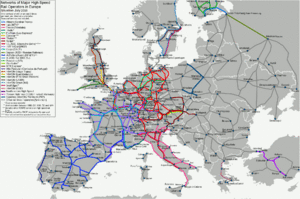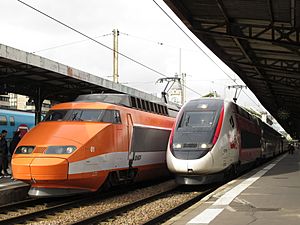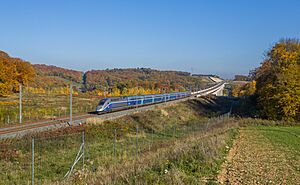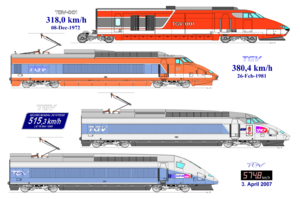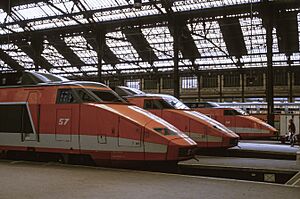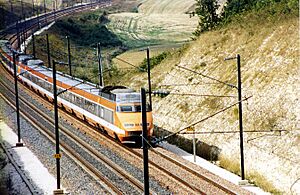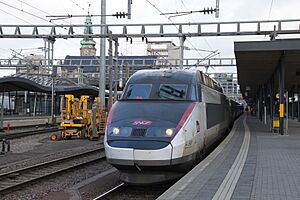TGV facts for kids
 |
|
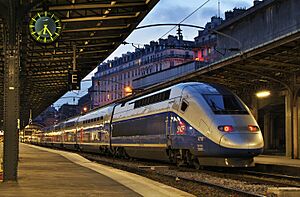
TGV 2N2 at Gare de l'Est in Paris, 2013
|
|
| Overview | |
|---|---|
| Locale |
|
| Dates of operation | 1981–present |
| Technical | |
| Track gauge | 1,435 mm (4 ft 8 1⁄2 in) (standard gauge) |

High-speed lines in France
|
The TGV is France's amazing high-speed rail service. TGV stands for train à grande vitesse, which means 'high-speed train' in French. These trains can travel at speeds up to 320 kilometers per hour (about 200 miles per hour) on their special tracks.
The TGV project started in 1966. It was approved in 1974. The first TGV trains were planned to use gas turbines. But after the 1973 oil crisis, they were changed to electric power. In 1976, the SNCF (France's national railway company) ordered 87 high-speed trains. The first TGV service began in 1981, connecting Paris and Lyon. Since then, the TGV network has grown a lot. It now connects many major cities across France and even goes into neighboring countries. The TGV has a great safety record. It has not had any passenger deaths in accidents on its high-speed lines.
A special TGV train, called Project V150, set a world record for the fastest wheeled train. On April 3, 2007, it reached an incredible speed of 574.8 kilometers per hour (about 357 miles per hour) during a test run. The TGV uses a special signaling system called TVM. This system helps drivers know what speed to go. It also helps trains keep a safe distance from each other. This means TGVs can leave the station every three minutes on the same line.
The TGV system also connects to nearby countries. This includes Italy, Spain, Belgium, Luxembourg, and Germany. Other high-speed trains like Lyria (to Switzerland) and Eurostar (to the UK) use TGV technology. The TGV has made travel much faster and easier in France. It even connects to airports and popular tourist spots like Disneyland Paris.
Contents
History of the TGV
The idea for the TGV came about in the 1960s. This was after Japan started building its own high-speed train, the Shinkansen. At that time, the French government was interested in new technologies. They were looking into things like hovercrafts and air-cushion vehicles. But the SNCF also started looking into fast trains for regular tracks. In 1976, the government decided to fund the first TGV line. By the mid-1990s, the TGV trains were so popular that they were called "the train that saved French railways."
How the TGV Was Developed
The first idea for the TGV was to power it with gas turbines. These were chosen because they were small and powerful. The first test train, TGV 001, used gas turbines. However, after the 1973 energy crisis, oil prices went up a lot. So, gas turbines became too expensive. The project then switched to using electricity from overhead lines. This electricity came from new nuclear power stations.
Even though TGV 001 used gas turbines, it was still very useful. It helped test many new technologies for high-speed trains. These included special brakes, aerodynamics (how the train moves through the air), and signaling systems. It also had a unique design where two carriages shared one set of wheels. This made the train more stable at high speeds. TGV 001 reached 318 kilometers per hour (about 198 miles per hour). This is still the world record for a non-electric train.
Changing the TGV to electric power meant a big redesign. The first electric test train, called Zébulon, was finished in 1974. It tested new features like how the motors were placed and how the train collected electricity. This test train traveled almost 1,000,000 kilometers (about 620,000 miles) during testing.
In 1976, the French government funded the TGV project. Soon after, construction began on the LGV Sud-Est. This was the first high-speed line. The first production TGV train was delivered on April 25, 1980.
TGV Service Begins

The TGV opened to the public between Paris and Lyon on September 27, 1981. The SNCF wanted the TGV to be for everyone, not just business travelers. They made the ticket prices the same as regular trains. They also launched a big advertising campaign. It focused on the TGV's speed, how often it ran, and that it was for everyone. People loved the TGV because it made travel fast and easy.
The Eurostar service started in 1994. It connects continental Europe to London through the Channel Tunnel. Eurostar trains use a version of TGV technology. The fastest Eurostar trains can go from London to Paris in 2 hours and 15 minutes. They can reach Brussels in 1 hour and 51 minutes.
TGV Milestones and Records
The TGV, launched in 1981, was the world's second commercial high-speed train service. It was also the fastest standard gauge high-speed train at the time. Japan's Shinkansen started in 1964. The TGV quickly became a big success.
A TGV test train holds the world speed record for conventional trains. On April 3, 2007, a special modified TGV POS train reached 574.8 kilometers per hour (about 357 miles per hour). This happened during a test on the LGV Est line. The train beat its own previous record from 1990. This test was part of a big research project.
In 2007, the TGV was the world's fastest regular scheduled train. It had an average speed of 279.3 kilometers per hour (about 173.6 miles per hour) between Champagne-Ardenne and Lorraine stations. This record was later broken by a Chinese high-speed railway in 2009.
A Eurostar (TGV) train also set a record. On May 17, 2006, it made the longest non-stop high-speed international journey. It traveled 1,421 kilometers (about 883 miles) from London to Cannes. The trip took 7 hours and 25 minutes.
The fastest single long-distance run on the TGV was by a TGV Réseau train. It went from Calais-Frethun to Marseille (1,067.2 kilometers or about 663 miles) in 3 hours and 29 minutes. This was at an average speed of 306 kilometers per hour (about 190 miles per hour).
How Many People Ride the TGV?
On November 28, 2003, the TGV network carried its one billionth passenger! This shows how popular it is. In 2008, the TGV system carried 98 million passengers within France. This was a big increase from the year before.
| 1980 | 1981 | 1982 | 1983 | 1984 | 1985 | 1986 | 1987 | 1988 | 1989 |
|---|---|---|---|---|---|---|---|---|---|
|
|
1.26 | 6.08 | 9.20 | 13.77 | 15.38 | 15.57 | 16.97 | 18.10 | 19.16 |
| 1990 | 1991 | 1992 | 1993 | 1994 | 1995 | 1996 | 1997 | 1998 | 1999 |
| 29.93 | 37.00 | 39.30 | 40.12 | 43.91 | 46.59 | 55.73 | 62.60 | 71.00 | 74.00 |
| 2000 | 2001 | 2002 | 2003 | 2004 | 2005 | 2006 | 2007 | 2008 | 2009 |
| 79.70 | 83.50 | 87.90 | 86.70 | 90.80 | 94.00 | 97.00 | 106.00 | 114.00 | 122.00 |
| 2010 | |||||||||
| 114.45 |
Types of TGV Trains
All TGV trains have two powerful engines, called power cars. One is at each end of the train. In between these power cars are passenger carriages. These carriages are connected in a special way. They share a single set of wheels, called a Jacobs bogie, between them. This design helps the train stay stable and safe, especially during a derailment. It makes it less likely for the carriages to tip over.
TGV trains can also be made longer by connecting two TGV sets together. This is done using special couplers hidden in the front of the power cars.
There are several types of TGV trains in use today. All of them are built by a company called Alstom.
- TGV Atlantique (10 carriages)
- TGV Réseau (an updated version of the Atlantique, 8 carriages)
- TGV Duplex (these have two floors for more passengers!)
- TGV POS (used for routes to Germany and Switzerland)
- TGV 2N2 (also known as Avelia Euroduplex, an update of the TGV Duplex)
- TGV M (also known as Avelia Horizon, expected to start service soon)
Some older TGV types are no longer in use:
- TGV Sud-Est (retired in 2019)
- TGV La Poste (mail trains, retired in 2015)
Many TGV types have broken speed records. The V150 was a special five-car train that reached 574.8 kilometers per hour (about 357 miles per hour) in a test. While TGVs can go super fast in tests, they usually travel at up to 320 kilometers per hour (about 200 miles per hour) for passengers. This is because going faster uses too much power and causes more wear on the tracks and trains.
All TGVs can use different types of electricity. This means they can travel on both high-speed lines and older, traditional lines. When a train moves from one electric system to another, the driver briefly turns off the power and lowers the pantograph (the arm that collects electricity). Then they switch to the new system and raise the pantograph again.
| Equipment type | Top speed | Seating capacity |
Overall length | Width | Weight, empty (t) |
Weight, full (t) |
Power, at 25 kV (kW) |
Power-to-weight ratio, empty (kW/t) |
First built |
Number in Service | |||
|---|---|---|---|---|---|---|---|---|---|---|---|---|---|
| km/h | mph | m | ft | m | ft | ||||||||
| TGV Atlantique | 300 | 190 | 485, 459 (rebuilt) | 238 | 781 | 2.90 | 9.5 | 444 | 484 | 8,800 | 19.82 | 1988 | 28 Trainsets |
| TGV Réseau | 320 | 200 | 377, 361 (rebuilt) | 200 | 660 | 2.90 | 9.5 | 383 | 415 | 8,800 | 22.98 | 1992 | 57 Trainsets |
| TGV Duplex | 320 | 200 | 508 | 200 | 660 | 2.90 | 9.5 | 380 | 424 | 8,800 | 23.16 | 1994 | 160 Trainsets |
| TGV POS | 320 | 200 | 361 | 200 | 660 | 2.90 | 9.5 | 383 | 415 | 9,280 | 24.23 | 2005 | 38 Trainsets |
| Euroduplex | 320 | 200 | 509(SNCF), 533(ONCF) | 200 | 660 | 2.90 | 9.5 | 380 | 424 | 9,400 | 24.74 | 2011 | 122 trainsets |
TGV Sud-Est Trains
The Sud-Est trains were built between 1978 and 1988. They were the first TGVs to run, starting service in 1981. There were 107 passenger trains. Most of them were updated to go 300 kilometers per hour (about 186 miles per hour). This was for the opening of the LGV Méditerranée line. These trains were retired from service in December 2019.
TGV Atlantique Trains
The Atlantique trains were built between 1988 and 1992. They started service in 1989. There are 105 of these trains. They are 237.5 meters (about 779 feet) long. Each train has two power cars and ten passenger carriages. They can carry 485 people. These trains were built to go 300 kilometers per hour (about 186 miles per hour).
A modified Atlantique train (unit 325) set a world speed record in 1990. It reached over 500 kilometers per hour (about 310 miles per hour). This was done on the LGV Atlantique line before it opened.
TGV Réseau Trains
The first Réseau (meaning "Network") trains started service in 1993. These trains have two power cars and eight carriages. They can carry 377 passengers. Their top speed is 320 kilometers per hour (about 200 miles per hour). They are 200 meters (about 656 feet) long. Some of these trains are used for international routes.
These trains are designed to be pressure-sealed. This helps passengers feel more comfortable when the train enters tunnels at high speed. They can also be connected to a Duplex train.
TGV Duplex Trains
The Duplex trains were built to carry more passengers without making the trains longer. Each carriage has two levels! This means they can carry 512 passengers per train. On busy routes, two Duplex trains can be connected. This creates a super-long train with over 1,000 seats.
The first Duplex trains were built between 1995 and 1998. Now, there are 160 of them. They are a very important part of the TGV fleet. They weigh 380 tonnes and are 200 meters (about 656 feet) long. They can go up to 320 kilometers per hour (about 200 miles per hour). Duplex TGVs run on all of France's high-speed lines.
TGV POS Trains
TGV POS trains are used on the LGV Est line. POS stands for Paris-Ostfrankreich-Süddeutschland (Paris-Eastern France-Southern Germany). These trains use Duplex power cars with eight TGV Réseau-type carriages. They have a top speed of 320 kilometers per hour (about 200 miles per hour).
Avelia Euroduplex (TGV 2N2) Trains
The TGV 2N2, also called Avelia Euroduplex, is the third generation of Duplex trains. These trains started service in December 2011. They are used for routes to Germany and Switzerland. They also help with the increased number of passengers since the LGV Rhine-Rhone line opened. These trains can go up to 320 kilometers per hour (about 200 miles per hour).
TGV M Avelia Horizon Trains
The TGV M, also known as Avelia Horizon, is a new design. The SNCF ordered 100 of these trains in July 2018. They are expected to start being delivered soon. These trains are designed to be very modern and efficient.
TGV Technology Around the World
TGV technology has been used in many other countries:
- AVE (Alta Velocidad Española) in Spain uses trains based on the TGV Atlantique.
- Eurostar trains connect France with Belgium, Germany, the Netherlands, and the United Kingdom. Many of these trains use TGV technology.
- Korea Train Express (KTX) in South Korea uses trains based on the TGV Réseau.
- Acela Express in the United States uses several TGV technologies. This includes the motors and braking systems.
- Avelia Liberty, which will replace the Acela Express in the United States, is also based on TGV technology.
- The Moroccan government bought TGV Euroduplex trains for their high-speed line between Tangier and Casablanca. This line opened in 2018.
TGV Lines in France
In June 2021, there were about 2,800 kilometers (about 1,740 miles) of high-speed lines in France. These are called Lignes à Grande Vitesse (LGV). There are also four new sections of lines being built. These lines mostly spread out from Paris in different directions.
TGV Safety Record
The TGV has a very good safety record. In over four decades of running, no passenger has died in an accident on the normal high-speed service. There have been a few derailments on the high-speed lines. But in only one of these did carriages overturn.
This great safety record is partly because of the TGV's special design. The carriages are connected in a way that makes the train very strong. This helps them stay upright and in line during an accident.
However, there have been some accidents on older, traditional lines. On these lines, TGVs face the same dangers as regular trains, like level crossings.
Accidents on High-Speed Lines (LGVs)
- December 14, 1992: A TGV derailed at Mâcon-Loché TGV station. No one on the train was hurt, but 25 people on the platform were slightly injured by flying rocks.
- December 21, 1993: A TGV derailed at the site of Haute Picardie TGV station. A hole under the track caused the accident. One passenger was slightly injured.
- June 5, 2000: A Eurostar train derailed near Croisilles. Parts from the train fell onto the track. Seven passengers were bruised, and others were treated for shock.
- November 14, 2015: TGV 2369 was involved in a derailment near Strasbourg during a test run. This accident resulted in 11 deaths among those on board. Excessive speed was the cause.
Accidents on Classic Lines
- December 31, 1983: A bomb exploded on a TGV from Marseille to Paris. Two people were killed.
- September 28, 1988: A TGV collided with a large truck stuck on a level crossing in Voiron. The train driver and one passenger died.
- January 4, 1991: A TGV ran away from a depot due to a brake problem. It crashed into a car loading ramp at Paris-Vaugirard station. No one was injured.
- September 25, 1997: A TGV collided with a paving machine on a level crossing near Dunkerque. Seven people were injured.
- October 31, 2001: A TGV derailed near Dax because of a broken rail. All ten carriages derailed.
- January 30, 2003: A TGV collided with a truck stuck on a level crossing in northern France. The driver was slightly injured.
- December 19, 2007: A TGV collided with a truck on a level crossing near Tossiat. The truck driver died. One person on the train was seriously injured, and 24 were slightly injured.
- July 17, 2014: A regional train crashed into the back of a TGV at Denguin. Forty people were injured.
Because of the accidents at level crossings, efforts have been made to remove all level crossings on traditional lines used by TGVs.
Protests Against the TGV
Some people have protested against building new TGV lines. In May 1990, during the planning of the LGV Méditerranée, protesters blocked a railway bridge. They felt the new line was not needed.
There have also been protests in Italy about the Turin–Lyon high-speed railway. This line would connect the TGV network to Italy's high-speed trains. Some people living in the towns where construction would happen are worried about dangerous materials from digging tunnels.
People also complain about the noise from TGVs passing near towns. So, the SNCF has built sound barriers along many parts of the high-speed lines to reduce the noise.
On July 26, 2024, the opening day of the 2024 Olympics, a TGV was damaged in an attack. This affected many people, and some Eurostar trains were canceled.
TGV Mail Services
For many years, special TGV trains were used to carry mail for the French mail service, La Poste. These trains looked like regular TGVs but had no windows and were painted yellow and blue. However, this mail service stopped in June 2015.
TGV Mobile Hospital Service
During the COVID-19 pandemic, some TGV trains were turned into mobile hospitals. They were used to move very sick patients from busy hospitals in eastern France to hospitals in the west. Each carriage could hold up to 6 patients. This allowed many patients to be moved safely. Even though the train moved fast, it was smooth enough for medical staff to care for patients during the journey.
TGV Rebranding
Since July 2017, TGV services have been slowly changing their names. They are now called TGV inOui and Ouigo. This is happening as France prepares for more competition in its high-speed rail market.
TGV inOui
TGV inOui is SNCF's main high-speed rail service. The name "inOui" sounds like the French word inouï, which means "extraordinary" or "unheard of."
Ouigo
Ouigo is SNCF's low-cost high-speed rail service. These trains have more seats and fewer services on board. They often operate from smaller stations outside the city center. The name "Ouigo" sounds like "we go" in English.
See also
 In Spanish: TGV para niños
In Spanish: TGV para niños
- High-speed rail in France
- High-speed rail in Europe
- Train categories in Europe


